#Marvel gets shazamed in to find no obvious problem just CAPTAIN MARVEL READ THIS
Explore tagged Tumblr posts
Text
i love this, but i also feel like he'd have made a habit of leaving himself notes long before it came to that.
conversation diary.
Marvel's handwriting is this beautiful even loopy cursive because The Wisdom of Solomon would definitely include penmanship, which was considered until basically right this moment in history a major indicator of intellectual competence, and by default Captain Marvel's virtues are showy. Billy writes like a precocious ten-year-old with uneven school attendance.
They are still visibly the same person talking to himself, if you really study the document.
So I was donating blood and was thinking of an AU where Billy knew he was Captain Marvel, knew how to access his powers but retained nothing of Marvel’s memories. A consequence of the magic is that the human mind can’t comprehend it so Billy transforms and essentially blacks out until he changes back. I can only imagine the sheer frustration of Bill having No Idea what he was up to as Marvel. His street buds think he’s the biggest Cap fanboy because he’s constantly tracking down down info on the heroes fights and missions in a desperate bid to understand.
Marvel himself would be Billy but maybe he too has a hard time connecting to his mortal self’s memories. He knows he’s from Fawcett City, that he struggles and barely scrapes by under difficult circumstances but he really can’t recall any details or information about Bill’s life. He may even forget that his true self is child. Pretty ironic if Cap is voting down introducing child sidekicks to the League.
Freddy is shaking Billy down for info about what the Justice League is like and Bill is red faced from frustrated tears because he knows Nothing. He knows via interviews that the JLA loves Marvel, trusts him and talks to him alot but he doesn’t remember. Superman probably told Marvel his identity but does Bill know? Nope and its incredibly annoying.
#billy's a capable problem-solver!#he got that reporter gig on his own merits mostly#ik he can't have a career in modern comics but children aren't incapable#Marvel gets shazamed in to find no obvious problem just CAPTAIN MARVEL READ THIS#and it's a letter from billy asking for after-action reports#a lot of the notes they'd immediately destroy because Sensitive Information#but for casual updates they could probably keep a notebook#just one of those floppy dollar-store ones with the perforated pages for easy tearing#i bet sometimes both billy and marvel just#eat the note they woke up to#just to be safe
3K notes
·
View notes
Text
Opinion piece: DC House of Horror (2017)
First of all SPOILERS for DC House of Horror!
Second, this is only my OPINION. It might be unpopular. It might even be offensive. But I want to talk about this before going back to my normally scheduled “hey look at this cool stuff” and “it’s stupid AU time!” content.
I did not read the Green Arrow and Captain Marvel/Shazam stories since I’m not currently invested in those characters. *shrugs*
The rest are...meh. The whole series seems to have Keith Giffen credited with the plot ideas, but each story has a different script writer. So I have no idea who I’m criticizing in each of these blurbs. Probably Keith. I don’t know.
Bump in the Night (feat Superman; by Edward Lee)
I have admittedly little experience with horror movie conventions, but I’m pretty sure this was aiming for the opening of a monster movie. Creepy, dangerous alien falls from space, kills the locals before making its way to more populated areas. The poor schmuck that finds it first always dies quickly and painfully, which is what happened to Pa Kent here. Kind of a cheap death, but it fits the genre convention.
The dramatic irony of Martha Kent trying to call her husband and her refusing to leave the house when something strange is happening outside were pulled off pretty well. Overall, I think she reads as a spirited but ultimately doomed horror protagonist.
My problem with this is that the alien (”Clark/Baby Superman”) reads as a complete cardboard-cutout monster cliche. Why did he kill Pa and Ma Kent? No reason is even alluded to. He just kills them because they’re there.
(If I were writing this, I would have played up the naive-creepy-child factor. Have Clark accidentally kill Jonathan Kent since he’s a child who doesn’t know his own strength and has never seen a dead person before. If you want to keep the alien-vibe, have him not recognize that he killed a person. Imagine a kid using a magnifying glass on an ant, then replace the ant with Pa and Ma Kent. I like to think that would have been more memorable.)
Man’s World (feat Wonder Woman; by Mary Sangiovanni)
Well, they definitely have the aesthetic they were going for. The mixed chronology is actually not as confusing as I was expecting since the artists made good use of the colors and a wardrobe change to help guide the reader through the flashbacks. I actually felt creeped out by this one.
The only problem is...this doesn’t read like Diana AT ALL. Having Diana not speak English is a great way to keep her menacing, but it also destroys any ability for the audience to know what’s going on in her head. Without her words, we have only her actions, and...she’s just going around killing people? Who haven’t done anything?? (Except the last guy, but he’s one out of six on-page deaths.)
What is her motivation? Why is she doing these things? What happened to Wonder Woman, righteous warrior and defender of the innocent?
(This would have been excellent if it was a villain character instead of Diana, just saying.)
Crazy for You (feat Harley Quinn; by Bryan Smith and Brian Keene)
Is it a ghost? Or is it a hallucination? Both? I’m not sure, and I love that I’m not sure.
That said, I’m definitely not a Harley expert...does she read in-character? I don’t know, she feels flat to me. And something about cutting hard away from witnessing the murders. Unreliable narrator is in effect, I want more concrete details of the murders from Chuck’s point of view.
Last Laugh (feat Batman; by Nick Cutter)
Ha. Hahaha. This is the one I reblogged panels from yesterday.
Good things first: capitalizing on Batman-Joker parallels has been done since forever, but that’s not necessarily a bad thing. I think the opening and closing scenes are well-narrated and well-composed. The much smaller batcave and the gun are good hints that something’s very different about this universe. The Joker’s voice was pretty good, for the most part. I wouldn’t change much of anything in the first half of this.
The second half...hahaha.
My beef with this one isn’t that Jason was killed; it was that he was killed for shock value and as an undisguised reference to super-(in)famous Death in the Family. It does not add constructively to the narrative at all. Last Laugh is clearly a hard AU with only the barest resemblance to canon; leaning so hard on canon that you only have one panel (technically two panels) with Jason in your story means that I just get angry instead of mournfully distraught when Jason is killed. It’s cheap and unearned in my opinion.
More broadly, there’s mixed signals as to the nature of Bruce’s delusion. Is he going around beating/killing people dressed as Batman? Or does he do his murders specifically dressed as the Joker? The later red panels indicate the former while the zoom-in on his locker at the end implies the latter. This whole story would have been much stronger if the writer had picked one interpretation and stuck with it from beginning to end.
(I would go with a strong Batman/Joker divide where Batman is still the vigilante and the Joker is the only “one” doing the crimes. Have the blue and red panels read as Batman vs Joker for most of the first read-through, but also have them consistently show Delusion vs Truth for the second read-through. I would also have Joker’s call-outs be a little more ambiguous so the twist actually sneaks up on you as opposed to be super obvious from the first red panel on.
And goddamn, if you’re going to kill Jason, at least have him show up in the narrative beforehand as Robin in the Delusion panel and ordinary-child-Jason in the Truth panel. Have him walk in on something he shouldn’t have, which leads to his murder and Bruce’s subsequent final mental break. Hell, maybe even imply that Robin was never really a thing outside Bruce’s head to really hammer home the death of a child who did nothing wrong.
Work for the tragedy, is all I’m saying.)
Blackest Day (feat Hal Jordan and Justice League; by Brian Keene)
In my opinion, this is the strongest of the lot. Zombie Barry compromising the moon base - because he was looking for help and didn’t realize he was already doomed - is excellent. And terrifying, because Zombie Barry could start the apocalypse by himself, imagine how many people he could bite in a minute. Liked how Hal held onto hope all the way up until he felt himself changing, then decided to take a Last Stand rather than let himself become part of the problem.
Superman being off-planet was cheap. The timeline for the End of the World seems super contracted based on Constantine’s transmission and the way the moon base was wholly in the dark. Wonder Woman and J’onn died very easily. Would have liked more fighting off the zombies, but this was short enough that there wasn’t a lot of time for that.
Having the World actually End...I’m never a fan of complete annihilation by zombies. (And what about Themyscira? Atlantis? Is DC Earth really completely depopulated?)
(I’m just saying, post-zombie-apocalypse AU. I’d read it.)
Unmasked (feat Two Face; by Wrath James White...that’s a weird name)
I think this one’s the weakest of the ones I read. I may not be the most well-read when it comes to Havey/Two-Face, but ugh. Serial Killer Harvey is something I don’t need in an official AU. Not to mention that that is not how skinning a person works - connective tissue between the skin and the muscle would mean that peeling each face would take way more time than shown.
The Leviathan thing also takes up way too many panels and accomplishes nothing. NOTHING.
#meta#opinion#idle thoughts#dc house of horror#spoilers#in summary: meh#interesting ideas#middling to poor execution#superman#wonder woman#batman#joker#justice league#two-face#harley quinn
2 notes
·
View notes
Text
Shazam: DC Comics Easter Eggs and References Guide
https://ift.tt/34LJ0no
Shazam! is more than just another DCEU movie, it is packed with 80 years of DC Comics history and Easter eggs.
facebook
twitter
tumblr
This article consists of nothing but Shazam! spoilers. We have a spoiler free review of the film here.
Shazam! marks the first time the character has come to the big screen as a big budget movie (1941's The Adventures of Captain Marvel was a serial, not a feature film). The movie is based heavily on one specific Shazam! story, the 2011 origin tale by Geoff Johns and Gary Frank, but throughout there are elements drawn from 80 years of Shazam history. We're trying to track down all the bits of Shazam and DC Universe lore peppered throughout the latest DCEU adventure...but we need your help.
So here's how this works. I've put everything I've found from the movie (so far) here. But if you think you've spotted something I missed, drop us a note in the comments or hit me up on Twitter and if it checks out, we'll get it added.
Who is Shazam?
OK, first thing's first...the character who, for the sake of simplicity and sanity we're going to call Shazam for the rest of this article was created by Bill Parker and C.C. Beck in 1939. And just in case you missed it in the film, the magic word "Shazam" grants you the wisdom of Solomon, the strength of Hercules, the stamina of Atlas, the power of Zeus, the courage of Achilles, and the speed of Mercury. What's interesting is that "the power of Zeus" was always pretty vague in the comics, and was often just interpreted as the explanation for the character's general invulnerability. It's only the recent comics that have given him the power to throw lightning, something which makes a lot more sense for a character with "Zeus" as a key part of his power set.
You're probably already aware of the confusing history surrounding the Shazam name and franchise. The character first appeared in Whiz Comics #2 in 1939, where he went by the name of (wait for it) Captain Marvel. The simplicity of the character really touched a nerve with young readers, and for a period in the 1940s, Shazam comics were outselling Superman comics. That didn't sit well with National Periodical Publications (who are now, of course, DC Comics), who sued the red and yellow pants off Fawcett, claiming that Cap and friends were ripoffs of Superman. By 1954, Fawcett finally agreed to cease publication of all Shazam related publications...and then DC revived the character in 1972.
read more: How Zachary Levi Was Cast as Shazam
The problem was that in 1972, DC had a notable competitor named...Marvel Comics. And Marvel had cannily created their OWN Captain Marvel a couple of years earlier. The solution? Instead of calling the new book Captain Marvel, the title was simply, Shazam!. For the next 30 or so years, the character's actual name never appeared on books, toys, shirts, cookies, whatever (even though he was still called Captain Marvel in the stories). DC finally gave in to the inevitable and just changed the character's actual name to Shazam in 2011.
And the 2011 story that did that is especially significant for this movie. The story, by Geoff Johns and Gary Frank, was a brand new take on the character's origins, and it is the heaviest, most obvious influence on the movie, from the look of the costume, to Billy having an extended foster family who all gain costumes of their own (traditionally, it had only been Freddy and Mary), to giving Dr. Sivana himself magical powers.
(whew) That was a lot. But speaking of that villain, we'd better get to...
Who is Dr. Sivana?
- Dr. Thaddeus Bodog Sivana (yes, his middle name is "Bodog" although that is never mentioned in the movie) first appeared in the very first Shazam story in Whiz Comics #2 in 1939. Oh, by the way...why did the first Shazam story appear in Whiz Comics #2 and not #1? Because there wasn't REALLY a Whiz Comics #1...at least not one that was made available to the public. Because of the vagaries of late 1930s magazine publishing, it was published as an "ashcan" edition, so the characters weren't seen by the public until #2.
read more: Mark Strong and the Secrets of Dr. Sivana
- The stuff about Sivana’s troubled boyhood is brand new, and has never really made it into any of the comics before. He’s referred to as “Thad” early on, which is short for Thaddeus. But in the comics, ol’ Dr. Sivana’s full name is Thaddeus Bodog Sivana. For real.
- As far as I know, we’ve never met Sivana’s father in the comics, but it’s interesting that they went with John Glover here. Not only because Glover played Lex Luthor’s father (to perfection) on Smallville, but because in the comics, the father of the Bryer brothers (the two bullies who torment Billy and his foster siblings) was a dead ringer for John Glover.
- For the vast majority of Sivana's comic book history, he was a sniveling, cackling mad scientist type, not the ice cold magic wielder we see in the movie. The change was made for the Geoff Johns/Gary Frank origin story in 2011 and has stuck around ever since.
- I don't believe we ever met Sivana's father or brother in the comics. On the other hand, we often met his kids, Magnificus, Beautia, Thaddeus Jr., and Georgia Sivana (get it?).
- While not an easter egg, young Sivana's Magic 8-Ball is a wonderful piece of kitsch.
- Sivana Industries comes from the Jerry Ordway Power of Shazam era of the character, where Sivana wasn't just a mad scientist, but an actual businessman and inventor.
- Sivana’s obsession with finding the entrance to the Rock of Eternity, complete with checking out people who claim to have been tested by the Wizard, is straight out of the New 52 comics. The reasoning is different, as in that story he was merely a kind of magic-obsessed relic hunter, rather than someone who had been chosen (and then rejected by the Wizard). But he was definitely studying others who had been rejected as "unworthy." (Incidentally, this movie says there have been 56 reported cases...I'm surprised they didn't go with the DC magic number of 52).
- The idea of Sivana slightly losing his powers as each Sin is sent off into the world is a little reminiscent of how the division of power between various members of the Shazam family has been portrayed. Basically, if Shazam and Sivana are "rivers" of magic, then as they empower other beings, they're branching off their main flow, which weakens them slightly.
- I'm not sure what the seven symbols are that Sivana draws on the door to access the Rock of Eternity (and that also appear on the subway before it changes into a magic train), but they MIGHT correspond to the runes carved on the thrones of the council of seven wizards in the comics. I'll have to take a closer look the next time I watch this.
We have more on the history of Dr. Sivana right here.
The Wizard
- Just to confuse things further...back when our hero was still called Captain Marvel, the wizard's name was Shazam. So, Billy would say the wizard's name to transform into Captain Marvel. Come to think of it, Shazam does sound more like a wizard's name than a superhero's name, but really, this is how it is, and if you try and think about all of this too hard it will only lead to headaches.
Nevertheless, the way the Wizard is presented in the movie as ancient, weary, ready to pass on his powers to a worthy candidate, is right out of the earliest Shazam stories, right down to his quest to find someone "pure of heart" for the role.
read more: Complete Schedule of Upcoming DCEU Superhero Movies
- Not only does the Wizard bear the lightning crest of Shazam, but you can see similarities in the design of his cloak to the cape that we’ll ultimately see on Billy. The idea is that the Wizard was a champion himself at some point in the distant past.
- The Wizard is looking for someone “Pure of heart” and “strong in spirit” to pass on the powers of the champion. Being “pure of heart” was a line straight from the earliest comics that the Wizard said to Billy when seeking him out.
- The idea of him being part of a "council of Wizards" is also from the New 52 origin story, and there are seven of them, just as their are seven deadly sins.
- The Wizard’s "death" is always key to completing this point in the origin story, in all versions of it. Don't be surprised if he pops up in sequels as a disembodied spirit, as traditionally, Billy and family are still able to communicate with the Wizard when necessary.
Billy Batson
Just a few fun points of reference about Billy Batson in the movie...
- Billy’s first words on screen are, appropriately enough, “holy moley" which was long both Billy and his superheroic alter ego's preferred exclamation of surprise.
- Billy has an omnipresent red hoodie, even when we see him as a toddler. Billy's fondness for red is more than just a foreshadowing of his superhero costume, since the character is pretty much ALWAYS depicted wearing red tops in the comics. But based on the logic of the movie and what went into the costume design (which I wrote more about here), it makes sense that his costume would have a ton of red in it, since his Shazam look is basically his own subconscious idealized version of a superhero.
- Billy saying “Shazam” to revert to kid size in order to slip out of the grip of a bad guy is a classic maneuver, used countless times in the comics.
- Billy has always been depicted as an orphan in the comics, although we only first got details about what happened to his parents in the 1987 limited series Shazam: The New Beginning by Roy Thomas and Tom Mandrake. There, his parents died in a car accident and Billy was taken in by his Uncle Dudley. In Jerry Ordway's brilliant The Power of Shazam series, his parents died on an archaeological expedition...one tied to the Shazam legend.
read more: Finding the Heroic Qualities in Shazam
- Billy’s parents are named Marilyn and C.C. Batson. The first time they were ever actually named in the comics was in Jerry Ordway's The Power of Shazam. C.C. is named after Charles Clarence Beck, the co-creator of Shazam.
It is said in this movie that Billy's mother Marilyn was born in Minnesota, and that's where C.C. Beck was born. Marilyn lives in apartment 707, which doesn't have any direct comics significance, but there is some parallel to 7 being a divine number, the council of seven wizards, and the seven deadly sins in the movie.
Incidentally, the voice of Marilyn's asshole boyfriend that you hear in the background is none other than director David F. Sandberg.
- In very recent Shazam comics, Billy's father has mysteriously resurfaced. It's not yet clear if he's an ex-con, since it's said in the movie that he is "in jail in Florida."
Who is Freddy?
- That would be Freddy Freeman, Billy's foster brother. Freddy has been around nearly as long as the Shazam comics themselves, first appearing in 1941's Whiz Comics #25, where he was created by France Herron and Mac Raboy.
read more: Finding the Right Tone for Shazam!
Freddy wasn't Billy's foster brother until the Geoff Johns/Gary Frank Shazam story. Instead, he was a teenager who had been injured by Captain Nazi. Feeling guilty that he didn't stop the villain sooner, Billy brought Freddy to the Rock of Eternity, where the wizard told him how he could pass a portion of his powers on to Freddy.
- The blue costume that Freddy wears in the movie when he transforms is an almost direct translation of his old "Captain Marvel Jr." look, which was always a pretty sharp costume.
Interestingly enough, the most famous Captain Marvel Jr. fan of all time was none other than Elvis Presley, who based a lot of his look on Mac Raboy's illustrations. Ever wonder why Elvis had a fondness for short capes and lightning bolts? There you go.
Who is Mary?
- That's Mary Bromfeld, created by Otto Binder and Marc Swayze way back in 1942. In most versions of the story, she's also Billy's long lost twin sister. The "twin" element has certainly been abandoned in recent comics because of the age gap between Billy and Mary, but it's not clear if they'll ever go down the route of making them blood relations again. It seems unlikely.
- Anyway, Mary was quite popular as a member of the Marvel Family (as they were called back in those simpler times), and the idea of a female superheroic counterpart to a super strong caped guy pre-dates Supergirl by about 16 years. Come to think of it, considering that DC went after Fawcett so hard with their claims that Shazam was ripping off Superman, they sure had no issues about making their own teenage version of their main hero (Superboy) in 1948 and a female (and blood related, no less!) version with Supergirl in 1958. The nerve!
The Rock of Eternity
- The Rock of Eternity has long been known as the source of the Shazam family powers, but here in the movie it is referred to as Rock of Eternity as “the source of all magic” in the DCEU.
- The idea of Billy taking a magical subway to the Rock of Eternity comes straight out of the original 1939 origin story in Whiz Comics #2 (although there, it was never a "normal" train first, but rather a crazy magical train that arrives in a normal, albeit closed, subway station), while the flourish with Billy first heading into the subway station to avoid the bullies comes from the New 52 comics.
- The first look at the Rock of Eternity interior, complete with the statues of the Seven Deadly Sins is straight out of the very first Shazam story from Whiz Comics #2. Of course there, it was Billy Batson not young Thad Sivana making that long walk for the first time, but that’s OK. The visuals are right on the money.
- Also visible in the Rock of Eternity is Mr. Mind in his glass case (later on we see he is missing, and then, of course, he appears in the post credits scene). More on Mr. Mind shortly!
- Also within the corners of the Rock of Eternity you can spot a mysterious old-fashioned mirror with gold trim. This matches a mirror from the New 52 origin story inhabited by "Francesca" a kind of magical spirit who offers Billy answers from time to time. She doesn't appear in the movie, but it's good to know that she could.
- I can't tell if I was imagining some kind of golden lamp in there or not. I know I was desperately wishing for it to be Dr. Fate's helmet, but alas, I know this was not the case.
- All of the doors that the kids are trying to navigate seem to be like the doors to the Magiclands from the most recent Shazam! series.
- One of those doors opens on a bunch of crocodile headed humanoids, which makes me think of Sobek, a crocodile creature who was first introduced as part of Mr. Mind's Monster Society of Evil, but got a modern update in DC's excellent weekly 52 series in 2006.
- Can someone explain the significance of what appears to be a burning violin in the Rock of Eternity? Because I am at a complete loss.
What about the tigers?
- Throughout the movie there’s a repeating tiger motif. Billy has a tiger patch on his backpack. Young Billy was trying to win a stuffed tiger at the carnival (and later hands a scared little girl one to hold on to). There are stuffed tigers visible in the toy store during the first fight with Sivana in the mall. If you look closely at the clasps on Shazam’s cape, they are embossed with tigers. Why is this? Well, tigers play a major role throughout Shazam history.
All of this is a reference to Mr. Tawny, a talking tiger who was a friend to Billy and family. Yes, a talking tiger. Look, if Marvel Studios can make Rocket Raccoon a layered, convincing, sympathetic character, I demand to see Tawky Tawny in Shazam 2.
The Family
So other than Billy Batson and Freddy Freeman, and Mary Bromfeld, the rest of the family includes Eugene Choi, Pedro Pena, and Darla Dudley. The latter three were introduced during DC's Flashpoint event, but had their proper introduction into the world of Shazam in the Geoff Johns/Gary Frank story that keeps getting mentioned in this piece. Their superheroic versions are perfect translations of what we see in that comic, too.
So...what are their superhero names? Ummmm...that hasn't been established yet. Freddy jokingly refers to himself as "King Shazam" once (remember the Elvis connection I mentioned up above?) but much about them still needs to be fleshed out. Each seems to embody specific qualities of the Shazam name, but they also seem to retain all of the other abilities as well. It's still a little murky, but all of this will probably be figured out by the time a sequel rolls around.
I went into more detail about the logic and magical rules behind all this right here.
However, note Darla's last name: Dudley. In the comics, Billy had an Uncle Dudley (only an actual blood relation in the Shazam: The New Beginning era, the rest of the time he was just kind of a friendly fraud) who would watch over him and occasionally partake in adventures. Perhaps Darla's uncle will show up in a sequel, too.
- It's nice to see that Eugene immediately does a hadouken from the Street Fighter games and then makes a "fatality" Mortal Kombat joke.
We have a complete history of everyone who has been able to wield the Shazam lightning right here.
The Seven Deadly Sins
- The seven deadly sins are Lust, Gluttony, Sloth, Wrath, Envy, Pride, and Greed. Each of them has appropriate physical characteristics. Shazam! director David F. Sandberg cites the Demon Dogs from Ghostbusters as an influence in their design.
They've been around as cautionary statues since the very first Shazam story, but I believe the first time they were "set loose" as embodiments of the sins themselves was during The Power of Shazam era. And, like many things in this movie, Sivana commanding the sins was a key component of that New 52 origin story, as well.
Black Adam
The champion who went bad that the Wizard refers to is Black Adam, who will be played by Dwayne Johnson in an upcoming DCEU movie. The character was created by Otto Binder and C.C. Beck in 1945, and was initially a one-off villain, who has since grown to not only be the most recognizable villain in the Shazam pantheon, but arguably is becoming more popular than the hero himself. We have all the details of why they kept Black Adam out of this movie right here.
The sequence where the Wizard describes Adam's misdeeds also continues the tradition of having a stylish exposition sequence explaining a particular corner of the DCEU, which dates back to the Kryptonian history lesson in Man of Steel, and was seen again in Wonder Woman, Aquaman, and more.
You can read more about the history of Black Adam right here.
Superman
- Freddy's room is like a shrine to the events of previous DCEU movies, including a recognizable batarang from Batman v Superman: Dawn of Justice, bullets that have bounced off Superman's chest, and more. Adorning Freddy’s walls are various newspapers depicting superheroic moments. One is cut off and it says Cong-...something. Please god, let this be a Congorilla reference. More importantly, also visible on Freddy’s wall is a Daily Planet front page with the headline “Caped Wonder Stuns City Under Siege.” While that has clearly been adapted for DCEU purposes, in Superman: The Movie, it was “Caped Wonder Stuns City.”
- If you listen carefully when Billy wakes up on the subway in full costume, it sounds like someone in the background calls him "Superman." And speaking of Superman, the guy hassling/complimenting Billy on his superhero look reminds me of the guy from Superman: The Movie, who was the first person to see Christopher Reeve's Man of Steel in full costume. "Say, Jim...wooooo!"
- There's a hint of a Superman II homage, as well. When Sivana makes Billy kneel before him so he can take his powers and Billy fakes him out, it sure is reminiscent of that classic moment when Supes gets Zod back in the Fortress of Solitude.
- Speaking of Superman, Billy describes the sensation of bullets bouncing off him as “It kinda tickles.” That reminds me of the iconic cover of 1944's Superman #32 by Wayne Boring, where Supes declares "it tickles" as he's being struck by lightning. Lightning, hmmmm...probably not a coincidence.
- And, of course, that's the DCEU Superman costume made famous in Man of Steel, Batman v Superman, and Justice League...but it isn't Henry Cavill in the suit, unfortunately (you can read an explanation of why Henry Cavill couldn't be Superman in Shazam! right here). At the moment, Cavill's future as Superman in the DCEU is unclear, but we're still holding out hope he'll come back. Don't hold your breath, though. Nevertheless, as Big Blue strolls into the cafeteria, you can hear the briefest hint of the classic John Williams Superman theme.
DCEU, DC Comics, and Other References
- Billy and the kids attend Fawcett Central, a reference to Fawcett Publications, who published Shazam comics for about the first 15 years of the characters' existence, and Fawcett City, where he operated out of. Although here, they call Philadelphia home. Why Philadelphia? Who knows? But the movie filmed under the working title of "Franklin," a reference to famous Philly resident (and American Founding Father) Benjamin Franklin, who had an affinity of his own for lightning.
- Can anyone make out what the book on Freddy’s desk is? Is it the David Graves book from the New 52 Justice League comics?
- Freddy makes reference to “Caped Crusader stuff” which is indeed a Batman thing. Interesting that a dated pop culture term like that still holds true in this world, and this (along with the fact that Batman has a toy line of his own) is a sign of how superheroes are viewed in the DCEU. The toys say "I'm Batman" (presumably in Kevin Conroy's voice), a line most famously uttered by Michael Keaton in the 1989 Tim Burton movie.
- When we meet Freddy, he is wearing an Aquaman shirt. That's pretty self explanatory. On the subject of Freddy's wardrobe, it appears that the Superman logo on his backpack is the New 52 logo, rather than the DCEU one.
- The magical and horror elements of the movie have a distinctly 1980s vibe. David F. Sandberg says that the look and feel of the Sins was inspired by the Demon Dogs in Ghostbusters. The stuff with the light under the door also feels like a Ghostbusters homage, and then Sivana’s lab assistant (played by Lotta Losten who is David F. Sandberg's wife and also appeared in Lights Out, both the short and the feature length version) croaks, that is another Ghostbusters-esque death.
Of course, any time you put John Glover in a corporate setting, it brings Gremlins 2 to mind, and the gleeful (and horrific) mayhem that ensues during that scene feels like a slightly amped up Joe Dante horror comedy.
And during the toy store fight, Sivana ends up charging at Billy on one of those giant floor pianos, much like Tom Hanks famously played on in Big.
- It's very possible that security guard "Moran" is more than just an excuse for a joke at the poor guy's expense. Mike Moran was the alter ego of Marvelman (better known in the US as Miracleman), the UK-only ripoff of the Shazam mythos who gaines greater fame (and infamy) when Alan Moore used him as a test subject for his "deconstructing superheroes" style.
- The song that plays over the end credits is "I Don't Wanna Grow Up" as performed by the pride of Forest Hills, New York, The Ramones. It was written by the brilliant Tom Waits for his essential and disturbing Bone Machine album.
The Post Credits Scenes
- Sivana madly scrawling heiroglyphics and mumbling to himself in order to potentially open a magical doorway seems a little more in keeping with the semi-broken nature of the character from the original comics. But Mr. Mind coming to him in his moment of need is reminiscent both of the end of that New 52 origin story and the end of Shazam: The New Beginning. Basically, Sivana and Mr. Mind have teamed up plenty of times, so this is a great way to set up a sequel. Oh, you probably want to know who Mr. Mind is.
- Mr. Mind is an extra-dimensional worm who feeds on brainwaves, and is capable of getting people to do his bidding. He first appeared in 1943 (created by the Shazam dream team of Otto Binder and C.C. Beck) and was actually the focal point of the first, long form serialized comic book storyline, "The Monster Society of Evil," which stretched out over two years of comics, at a time when most superhero stories were completely self contained. He was considered so dangerous that he was tried, convicted, and given the death penalty (hey, it was the '40s) and put to death in a tiny little worm-sized electric chair. Because comics are crazy but also the best.
In more recent years it was revealed that he was merely in his larval stage this entire time, and evolves into something called a hyperfly, capable of devouring the entire DC Multiverse (something he intended and attempted to do). Again, because comics are crazy/the best.
Anyway, I love that they even leaned into the tiny speaker hanging around his neck. And the voice of Mr. Mind? That would be Shazam! director David F. Sandberg again!
By the way, just as this movie was a nearly dead on adaptation of that Geoff Johns/Gary Frank story, the current ongoing Shazam! comic book series seems to be perfect fodder for a potential Shazam 2, with the kids exploring "The Magiclands" that can be accessed via the Rock of Eternity.
I went into much more detail about what these post-credits scenes mean right here.
- I don't really need to explain that Freddy is talking about the events from the end of Aquaman in that second scene, do I? No? Good.
So, did we miss anything? Let us know in the comments or hit me up on Twitter!
Mike Cecchini is the Editor in Chief of Den of Geek. You can read more of his work here. Follow him on Twitter @wayoutstuff.
Read and download the Den of Geek NYCC 2019 Special Edition Magazine right here!
facebook
twitter
tumblr

Feature
Books
Mike Cecchini
Dec 3, 2019
Shazam
DC Entertainment
from Books https://ift.tt/2Ie13tZ
0 notes
Text
Shazam! Complete Guide to DC Comics Easter Eggs and References
https://ift.tt/2I0Bgq2
Shazam! is more than just another DCEU movie, it is packed with 80 years of DC Comics history and Easter eggs.
facebook
twitter
google+
tumblr
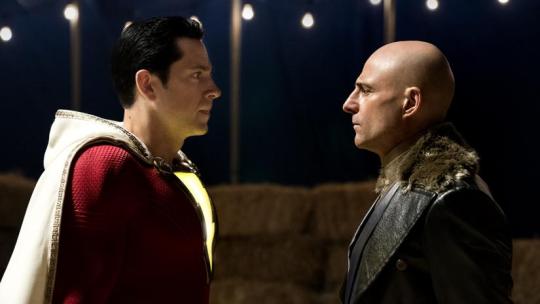
Feature
Books
Mike Cecchini
Shazam
Apr 4, 2019
DC Entertainment
This article consists of nothing but Shazam! spoilers. We have a spoiler free review of the film here.
Shazam! is the first time the character has come to the big screen as a big budget movie (1941's The Adventures of Captain Marvel was a serial, not a feature film). The movie is based heavily on one specific Shazam! story, the 2011 origin tale by Geoff Johns and Gary Frank, but throughout there are elements drawn from 80 years of Shazam history. We're trying to track down all the bits of Shazam and DC Universe lore peppered throughout the latest DCEU adventure...but we need your help.
So here's how this works. I've put everything I've found from the movie (so far) here. But if you think you've spotted something I missed, drop us a note in the comments or hit me up on Twitter and if it checks out, we'll get it added.
Who is Shazam?
OK, first thing's first...the character who, for the sake of simplicity and sanity we're going to call Shazam for the rest of this article was created by Bill Parker and C.C. Beck in 1939. And just in case you missed it in the film, the magic word "Shazam" grants you the wisdom of Solomon, the strength of Hercules, the stamina of Atlas, the power of Zeus, the courage of Achilles, and the speed of Mercury. What's interesting is that "the power of Zeus" was always pretty vague in the comics, and was often just interpreted as the explanation for the character's general invulnerability. It's only the recent comics that have given him the power to throw lightning, something which makes a lot more sense for a character with "Zeus" as a key part of his power set.
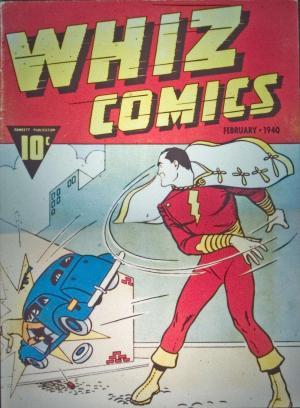
You're probably already aware of the confusing history surrounding the Shazam name and franchise. The character first appeared in Whiz Comics #2 in 1939, where he went by the name of (wait for it) Captain Marvel. The simplicity of the character really touched a nerve with young readers, and for a period in the 1940s, Shazam comics were outselling Superman comics. That didn't sit well with National Periodical Publications (who are now, of course, DC Comics), who sued the red and yellow pants off Fawcett, claiming that Cap and friends were ripoffs of Superman. By 1954, Fawcett finally agreed to cease publication of all Shazam related publications...and then DC revived the character in 1972.
read more: How Zachary Levi Was Cast as Shazam
The problem was that in 1972, DC had a notable competitor named...Marvel Comics. And Marvel had cannily created their OWN Captain Marvel a couple of years earlier. The solution? Instead of calling the new book Captain Marvel, the title was simply, Shazam!. For the next 30 or so years, the character's actual name never appeared on books, toys, shirts, cookies, whatever (even though he was still called Captain Marvel in the stories). DC finally gave in to the inevitable and just changed the character's actual name to Shazam in 2011.
And the 2011 story that did that is especially significant for this movie. The story, by Geoff Johns and Gary Frank, was a brand new take on the character's origins, and it is the heaviest, most obvious influence on the movie, from the look of the costume, to Billy having an extended foster family who all gain costumes of their own (traditionally, it had only been Freddy and Mary), to giving Dr. Sivana himself magical powers.
(whew) That was a lot. But speaking of that villain, we'd better get to...
Who is Dr. Sivana?
- Dr. Thaddeus Bodog Sivana (yes, his middle name is "Bodog" although that is never mentioned in the movie) first appeared in the very first Shazam story in Whiz Comics #2 in 1939. Oh, by the way...why did the first Shazam story appear in Whiz Comics #2 and not #1? Because there wasn't REALLY a Whiz Comics #1...at least not one that was made available to the public. Because of the vagaries of late 1930s magazine publishing, it was published as an "ashcan" edition, so the characters weren't seen by the public until #2.
read more: Mark Strong and the Secrets of Dr. Sivana
- The stuff about Sivana’s troubled boyhood is brand new, and has never really made it into any of the comics before. He’s referred to as “Thad” early on, which is short for Thaddeus. But in the comics, ol’ Dr. Sivana’s full name is Thaddeus Bodog Sivana. For real.
- As far as I know, we’ve never met Sivana’s father in the comics, but it’s interesting that they went with John Glover here. Not only because Glover played Lex Luthor’s father (to perfection) on Smallville, but because in the comics, the father of the Bryer brothers (the two bullies who torment Billy and his foster siblings) was a dead ringer for John Glover.
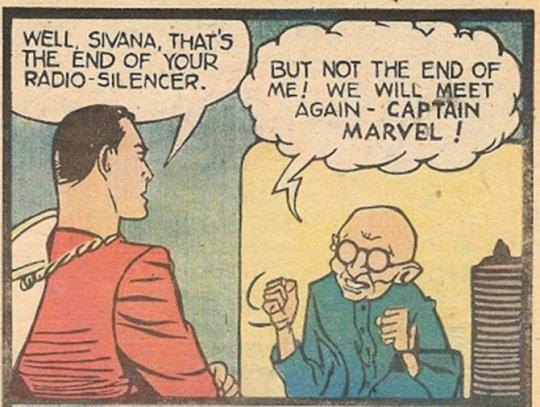
- For the vast majority of Sivana's comic book history, he was a sniveling, cackling mad scientist type, not the ice cold magic wielder we see in the movie. The change was made for the Geoff Johns/Gary Frank origin story in 2011 and has stuck around ever since.
- I don't believe we ever met Sivana's father or brother in the comics. On the other hand, we often met his kids, Magnificus, Beautia, Thaddeus Jr., and Georgia Sivana (get it?).
- While not an easter egg, young Sivana's Magic 8-Ball is a wonderful piece of kitsch.
- Sivana Industries comes from the Jerry Ordway Power of Shazam era of the character, where Sivana wasn't just a mad scientist, but an actual businessman and inventor.
- Sivana’s obsession with finding the entrance to the Rock of Eternity, complete with checking out people who claim to have been tested by the Wizard, is straight out of the New 52 comics. The reasoning is different, as in that story he was merely a kind of magic-obsessed relic hunter, rather than someone who had been chosen (and then rejected by the Wizard). But he was definitely studying others who had been rejected as "unworthy." (Incidentally, this movie says there have been 56 reported cases...I'm surprised they didn't go with the DC magic number of 52).
- The idea of Sivana slightly losing his powers as each Sin is sent off into the world is a little reminiscent of how the division of power between various members of the Shazam family has been portrayed. Basically, if Shazam and Sivana are "rivers" of magic, then as they empower other beings, they're branching off their main flow, which weakens them slightly.
- I'm not sure what the seven symbols are that Sivana draws on the door to access the Rock of Eternity (and that also appear on the subway before it changes into a magic train), but they MIGHT correspond to the runes carved on the thrones of the council of seven wizards in the comics. I'll have to take a closer look the next time I watch this.
We have more on the history of Dr. Sivana right here.
The Wizard
- Just to confuse things further...back when our hero was still called Captain Marvel, the wizard's name was Shazam. So, Billy would say the wizard's name to transform into Captain Marvel. Come to think of it, Shazam does sound more like a wizard's name than a superhero's name, but really, this is how it is, and if you try and think about all of this too hard it will only lead to headaches.
Nevertheless, the way the Wizard is presented in the movie as ancient, weary, ready to pass on his powers to a worthy candidate, is right out of the earliest Shazam stories, right down to his quest to find someone "pure of heart" for the role.
read more: Complete Schedule of Upcoming DCEU Superhero Movies
- Not only does the Wizard bear the lightning crest of Shazam, but you can see similarities in the design of his cloak to the cape that we’ll ultimately see on Billy. The idea is that the Wizard was a champion himself at some point in the distant past.
- The Wizard is looking for someone “Pure of heart” and “strong in spirit” to pass on the powers of the champion. Being “pure of heart” was a line straight from the earliest comics that the Wizard said to Billy when seeking him out.
- The idea of him being part of a "council of Wizards" is also from the New 52 origin story, and there are seven of them, just as their are seven deadly sins.
- The Wizard’s "death" is always key to completing this point in the origin story, in all versions of it. Don't be surprised if he pops up in sequels as a disembodied spirit, as traditionally, Billy and family are still able to communicate with the Wizard when necessary.
Billy Batson
Just a few fun points of reference about Billy Batson in the movie...
- Billy’s first words on screen are, appropriately enough, “holy moley" which was long both Billy and his superheroic alter ego's preferred exclamation of surprise.
- Billy has an omnipresent red hoodie, even when we see him as a toddler. Billy's fondness for red is more than just a foreshadowing of his superhero costume, since the character is pretty much ALWAYS depicted wearing red tops in the comics. But based on the logic of the movie and what went into the costume design (which I wrote more about here), it makes sense that his costume would have a ton of red in it, since his Shazam look is basically his own subconscious idealized version of a superhero.
- Billy saying “Shazam” to revert to kid size in order to slip out of the grip of a bad guy is a classic maneuver, used countless times in the comics.
- Billy has always been depicted as an orphan in the comics, although we only first got details about what happened to his parents in the 1987 limited series Shazam: The New Beginning by Roy Thomas and Tom Mandrake. There, his parents died in a car accident and Billy was taken in by his Uncle Dudley. In Jerry Ordway's brilliant The Power of Shazam series, his parents died on an archaeological expedition...one tied to the Shazam legend.
read more: Finding the Heroic Qualities in Shazam
- Billy’s parents are named Marilyn and C.C. Batson. The first time they were ever actually named in the comics was in Jerry Ordway's The Power of Shazam. C.C. is named after Charles Clarence Beck, the co-creator of Shazam.
It is said in this movie that Billy's mother Marilyn was born in Minnesota, and that's where C.C. Beck was born. Marilyn lives in apartment 707, which doesn't have any direct comics significance, but there is some parallel to 7 being a divine number, the council of seven wizards, and the seven deadly sins in the movie.
Incidentally, the voice of Marilyn's asshole boyfriend that you hear in the background is none other than director David F. Sandberg.
- In very recent Shazam comics, Billy's father has mysteriously resurfaced. It's not yet clear if he's an ex-con, since it's said in the movie that he is "in jail in Florida."
Who is Freddy?
- That would be Freddy Freeman, Billy's foster brother. Freddy has been around nearly as long as the Shazam comics themselves, first appearing in 1941's Whiz Comics #25, where he was created by France Herron and Mac Raboy.
read more: Finding the Right Tone for Shazam!
Freddy wasn't Billy's foster brother until the Geoff Johns/Gary Frank Shazam story. Instead, he was a teenager who had been injured by Captain Nazi. Feeling guilty that he didn't stop the villain sooner, Billy brought Freddy to the Rock of Eternity, where the wizard told him how he could pass a portion of his powers on to Freddy.
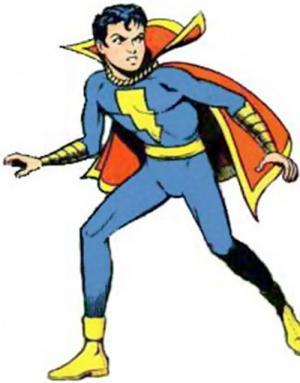
- The blue costume that Freddy wears in the movie when he transforms is an almost direct translation of his old "Captain Marvel Jr." look, which was always a pretty sharp costume.
Interestingly enough, the most famous Captain Marvel Jr. fan of all time was none other than Elvis Presley, who based a lot of his look on Mac Raboy's illustrations. Ever wonder why Elvis had a fondness for short capes and lightning bolts? There you go.
Who is Mary?
- That's Mary Bromfeld, created by Otto Binder and Marc Swayze way back in 1942. In most versions of the story, she's also Billy's long lost twin sister. The "twin" element has certainly been abandoned in recent comics because of the age gap between Billy and Mary, but it's not clear if they'll ever go down the route of making them blood relations again. It seems unlikely.
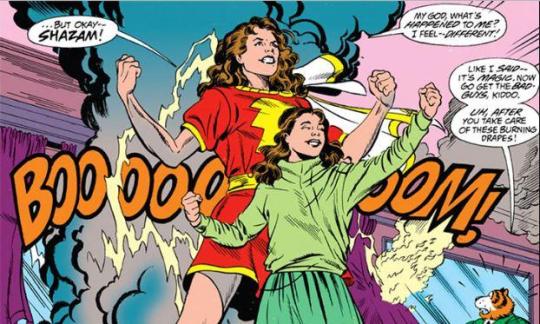
- Anyway, Mary was quite popular as a member of the Marvel Family (as they were called back in those simpler times), and the idea of a female superheroic counterpart to a super strong caped guy pre-dates Supergirl by about 16 years. Come to think of it, considering that DC went after Fawcett so hard with their claims that Shazam was ripping off Superman, they sure had no issues about making their own teenage version of their main hero (Superboy) in 1948 and a female (and blood related, no less!) version with Supergirl in 1958. The nerve!
The Rock of Eternity
- The Rock of Eternity has long been known as the source of the Shazam family powers, but here in the movie it is referred to as Rock of Eternity as “the source of all magic” in the DCEU.
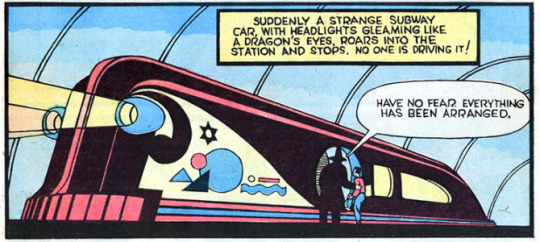
- The idea of Billy taking a magical subway to the Rock of Eternity comes straight out of the original 1939 origin story in Whiz Comics #2 (although there, it was never a "normal" train first, but rather a crazy magical train that arrives in a normal, albeit closed, subway station), while the flourish with Billy first heading into the subway station to avoid the bullies comes from the New 52 comics.
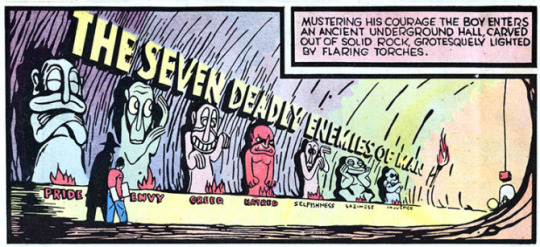
- The first look at the Rock of Eternity interior, complete with the statues of the Seven Deadly Sins is straight out of the very first Shazam story from Whiz Comics #2. Of course there, it was Billy Batson not young Thad Sivana making that long walk for the first time, but that’s OK. The visuals are right on the money.
- Also visible in the Rock of Eternity is Mr. Mind in his glass case (later on we see he is missing, and then, of course, he appears in the post credits scene). More on Mr. Mind shortly!
- Also within the corners of the Rock of Eternity you can spot a mysterious old-fashioned mirror with gold trim. This matches a mirror from the New 52 origin story inhabited by "Francesca" a kind of magical spirit who offers Billy answers from time to time. She doesn't appear in the movie, but it's good to know that she could.
- I can't tell if I was imagining some kind of golden lamp in there or not. I know I was desperately wishing for it to be Dr. Fate's helmet, but alas, I know this was not the case.
- All of the doors that the kids are trying to navigate seem to be like the doors to the Magiclands from the most recent Shazam! series.
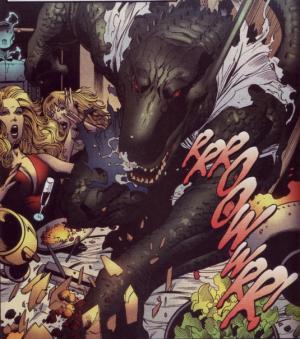
- One of those doors opens on a bunch of crocodile headed humanoids, which makes me think of Sobek, a crocodile creature who was first introduced as part of Mr. Mind's Monster Society of Evil, but got a modern update in DC's excellent weekly 52 series in 2006.
- Can someone explain the significance of what appears to be a burning violin in the Rock of Eternity? Because I am at a complete loss.
What about the tigers?
- Throughout the movie there’s a repeating tiger motif. Billy has a tiger patch on his backpack. Young Billy was trying to win a stuffed tiger at the carnival (and later hands a scared little girl one to hold on to). There are stuffed tigers visible in the toy store during the first fight with Sivana in the mall. If you look closely at the clasps on Shazam’s cape, they are embossed with tigers. Why is this? Well, tigers play a major role throughout Shazam history.
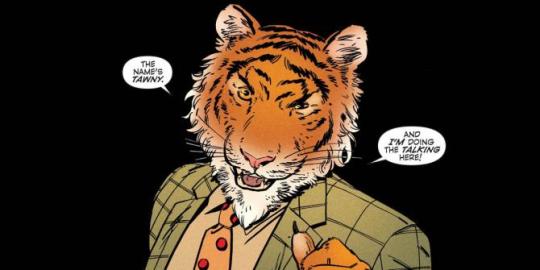
All of this is a reference to Mr. Tawny, a talking tiger who was a friend to Billy and family. Yes, a talking tiger. Look, if Marvel Studios can make Rocket Raccoon a layered, convincing, sympathetic character, I demand to see Tawky Tawny in Shazam 2.
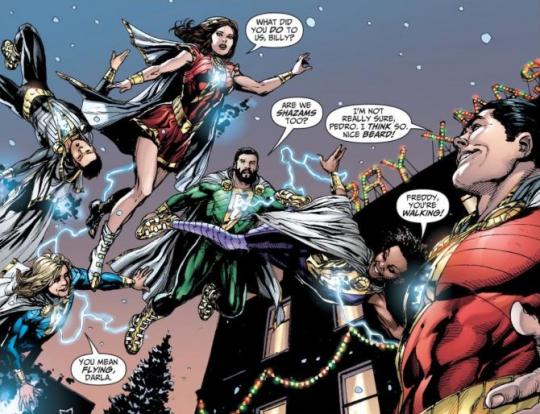
The Family
So other than Billy Batson and Freddy Freeman, and Mary Bromfeld, the rest of the family includes Eugene Choi, Pedro Pena, and Darla Dudley. The latter three were introduced during DC's Flashpoint event, but had their proper introduction into the world of Shazam in the Geoff Johns/Gary Frank story that keeps getting mentioned in this piece. Their superheroic versions are perfect translations of what we see in that comic, too.
So...what are their superhero names? Ummmm...that hasn't been established yet. Freddy jokingly refers to himself as "King Shazam" once (remember the Elvis connection I mentioned up above?) but much about them still needs to be fleshed out. Each seems to embody specific qualities of the Shazam name, but they also seem to retain all of the other abilities as well. It's still a little murky, but all of this will probably be figured out by the time a sequel rolls around.
However, note Darla's last name: Dudley. In the comics, Billy had an Uncle Dudley (only an actual blood relation in the Shazam: The New Beginning era, the rest of the time he was just kind of a friendly fraud) who would watch over him and occasionally partake in adventures. Perhaps Darla's uncle will show up in a sequel, too.
- It's nice to see that Eugene immediately does a hadouken from the Street Fighter games and then makes a "fatality" Mortal Kombat joke.
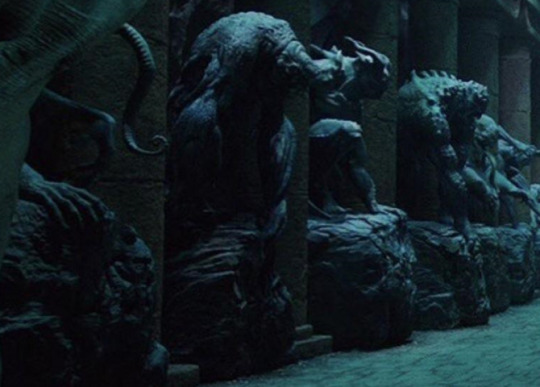
The Seven Deadly Sins
- The seven deadly sins are Lust, Gluttony, Sloth, Wrath, Envy, Pride, and Greed. Each of them has appropriate physical characteristics. Shazam! director David F. Sandberg cites the Demon Dogs from Ghostbusters as an influence in their design.
They've been around as cautionary statues since the very first Shazam story, but I believe the first time they were "set loose" as embodiments of the sins themselves was during The Power of Shazam era. And, like many things in this movie, Sivana commanding the sins was a key component of that New 52 origin story, as well.
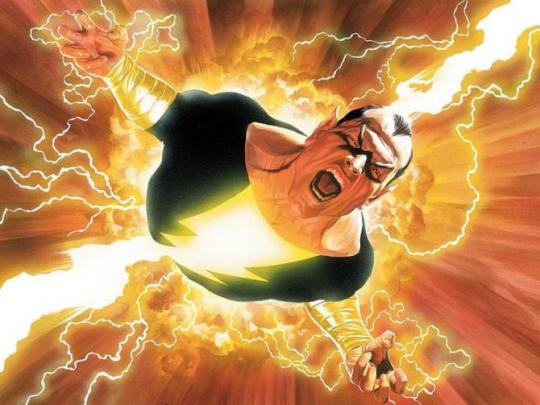
Black Adam
The champion who went bad that the Wizard refers to is Black Adam, who will be played by Dwayne Johnson in an upcoming DCEU movie. The character was created by Otto Binder and C.C. Beck in 1945, and was initially a one-off villain, who has since grown to not only be the most recognizable villain in the Shazam pantheon, but arguably is becoming more popular than the hero himself.
The sequence where the Wizard describes Adam's misdeeds also continues the tradition of having a stylish exposition sequence explaining a particular corner of the DCEU, which dates back to the Kryptonian history lesson in Man of Steel, and was seen again in Wonder Woman, Aquaman, and more.
Superman
- Freddy's room is like a shrine to the events of previous DCEU movies, including a recognizable batarang from Batman v Superman: Dawn of Justice, bullets that have bounced off Superman's chest, and more. Adorning Freddy’s walls are various newspapers depicting superheroic moments. One is cut off and it says Cong-...something. Please god, let this be a Congorilla reference. More importantly, also visible on Freddy’s wall is a Daily Planet front page with the headline “Caped Wonder Stuns City Under Siege.” While that has clearly been adapted for DCEU purposes, in Superman: The Movie, it was “Caped Wonder Stuns City.”
- If you listen carefully when Billy wakes up on the subway in full costume, it sounds like someone in the background calls him "Superman." And speaking of Superman, the guy hassling/complimenting Billy on his superhero look reminds me of the guy from Superman: The Movie, who was the first person to see Christopher Reeve's Man of Steel in full costume. "Say, Jim...wooooo!"
- Speaking of Superman, Billy describes the sensation of bullets bouncing off him as “It kinda tickles.” That reminds me of the iconic cover of 1944's Superman #32 by Wayne Boring, where Supes declares "it tickles" as he's being struck by lightning. Lightning, hmmmm...probably not a coincidence.
- And, of course, that's the DCEU Superman costume made famous in Man of Steel, Batman v Superman, and Justice League...but it isn't Henry Cavill in the suit, unfortunately. At the moment, Cavill's future as Superman in the DCEU is unclear, but we're still holding out hope he'll come back. Don't hold your breath, though. Nevertheless, as Big Blue strolls into the cafeteria, you can hear the briefest hint of the classic John Williams Superman theme.
DCEU, DC Comics, and Other References
- Billy and the kids attend Fawcett Central, a reference to Fawcett Publications, who published Shazam comics for about the first 15 years of the characters' existence, and Fawcett City, where he operated out of. Although here, they call Philadelphia home. Why Philadelphia? Who knows? But the movie filmed under the working title of "Franklin," a reference to famous Philly resident (and American Founding Father) Benjamin Franklin, who had an affinity of his own for lightning.
- Can anyone make out what the book on Freddy’s desk is? Is it the David Graves book from the New 52 Justice League comics?
- Freddy makes reference to “Caped Crusader stuff” which is indeed a Batman thing. Interesting that a dated pop culture term like that still holds true in this world, and this (along with the fact that Batman has a toy line of his own) is a sign of how superheroes are viewed in the DCEU. The toys say "I'm Batman" (presumably in Kevin Conroy's voice), a line most famously uttered by Michael Keaton in the 1989 Tim Burton movie.
- When we meet Freddy, he is wearing an Aquaman shirt. That's pretty self explanatory. On the subject of Freddy's wardrobe, it appears that the Superman logo on his backpack is the New 52 logo, rather than the DCEU one.
- The magical and horror elements of the movie have a distinctly 1980s vibe. David F. Sandberg says that the look and feel of the Sins was inspired by the Demon Dogs in Ghostbusters. The stuff with the light under the door also feels like a Ghostbusters homage, and then Sivana’s lab assistant croaks, that is another Ghostbusters-esque death.
Of course, any time you put John Glover in a corporate setting, it brings Gremlins 2 to mind, and the gleeful (and horrific) mayhem that ensues during that scene feels like a slightly amped up Joe Dante horror comedy.
- The song that plays over the end credits is "I Don't Wanna Grow Up" as performed by the pride of Forest Hills, New York, The Ramones. It was written by the brilliant Tom Waits for his essential and disturbing Bone Machine album.
The Post Credits Scenes
- Sivana madly scrawling heiroglyphics and mumbling to himself in order to potentially open a magical doorway seems a little more in keeping with the semi-broken nature of the character from the original comics. But Mr. Mind coming to him in his moment of need is reminiscent both of the end of that New 52 origin story and the end of Shazam: The New Beginning. Basically, Sivana and Mr. Mind have teamed up plenty of times, so this is a great way to set up a sequel. Oh, you probably want to know who Mr. Mind is.
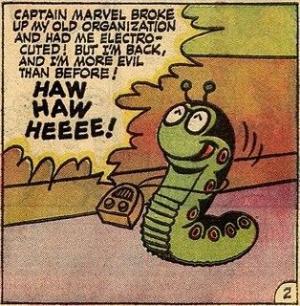
- Mr. Mind is an extra-dimensional worm who feeds on brainwaves, and is capable of getting people to do his bidding. He first appeared in 1945 (created by the Shazam dream team of Otto Binder and C.C. Beck) and was actually the focal point of the first, long form serialized comic book storyline, "The Monster Society of Evil," which stretched out over two years of comics, at a time when most superhero stories were completely self contained. He was considered so dangerous that he was tried, convicted, and given the death penalty (hey, it was the '40s) and put to death in a tiny little worm-sized electric chair. Because comics are crazy but also the best.
In more recent years it was revealed that he was merely in his larval stage this entire time, and evolves into something called a hyperfly, capable of devouring the entire DC Multiverse (something he intended and attempted to do). Again, because comics are crazy/the best.
Anyway, I love that they even leaned into the tiny speaker hanging around his neck. And the voice of Mr. Mind? That would be Shazam! director David F. Sandberg again!
By the way, just as this movie was a nearly dead on adaptation of that Geoff Johns/Gary Frank story, the current ongoing Shazam! comic book series seems to be perfect fodder for a potential Shazam 2, with the kids exploring "The Magiclands" that can be accessed via the Rock of Eternity.
- I don't really need to explain that Freddy is talking about the events from the end of Aquaman in that second scene, do I? No? Good.
So, did we miss anything? Let us know in the comments or hit me up on Twitter!
Mike Cecchini is the Editor in Chief of Den of Geek. You can read more of his work here. Follow him on Twitter @wayoutstuff.
from Books https://ift.tt/2Ie13tZ
0 notes